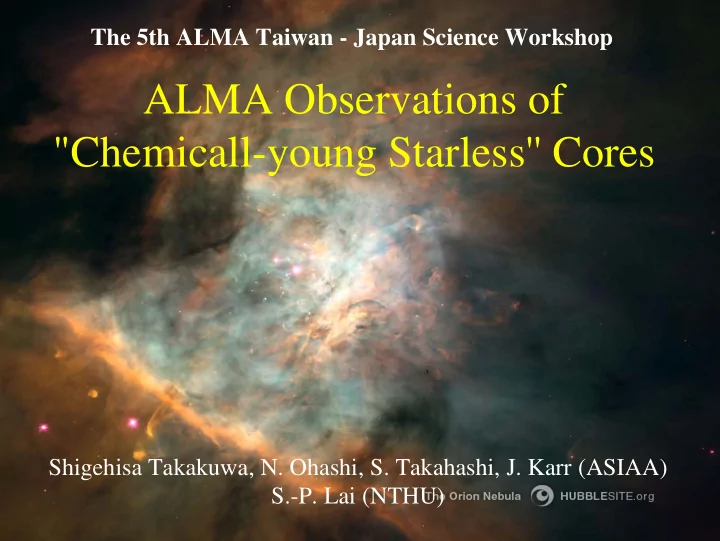

The 5th ALMA Taiwan - Japan Science Workshop ALMA Observations of "Chemicall-young Starless'' Cores Shigehisa Takakuwa, N. Ohashi, S. Takahashi, J. Karr (ASIAA) S.-P. Lai (NTHU)
Table of Contents 1. Chemistry as a Diagnostics of Star Formation 2. VeLLOs: Candidates of the Youngest Protostars 3. ALMA Observations
1. Chemistry as a diagnostics of Star Formation Hunt for the earliest stage of protostellar formation the initial stage is likely to constrain the properties of the final product such as the stellar mass and the planetary system � Chemical Status of Dense Cores, out of which protostars form, might help, since…
The Molecular Abundances vary as a function of time, mainly because of A. the time evolution of the gas-phase status of Carbon C + --> C --> CO CCS (and other Carbon-Chain Molecules)---> produced from C + , then traces early evolutionary stage CO, HCO + ---> from CO, later evolutionary stage NH 3 , N 2 H + --> neutral-neutral reaction, later evolutionary stage, B. Depletion of molecules onto dust grains CO, HCO + depletion at the cold-gas center NH 3 , N 2 H + also depleted but only at the latest evolutionary stage C. Desorption of molecules from dust grains due to the protostellar heating CO, and organic molecules
Molecular Desorption Once a Protostar forms, heating from the star desorbs molecules which were depleted onto dust grains in the starless phase. Aikawa et al. 2008 Radius (AU) Temperature enhancement Molecular desorption in the star-forming dense core due to the heating CO sublimate to gas phase @ T K > 20 K --> compact CO emission at the center as a sign of star formation ?
2. VeLLOs: Candidates of the Youngest Protostars Very Low-Luminosity Objects (< 0.1 L solar ), detected by Spitzer in previously-thought ``starless cores’’, cannot be detected with IRAS Candidates of the youngest protostars (But Not easy to dintiguish youngest or lowest-mass) L1014 (Young et al. 2004) Class 0 Like SED ---------------> Higher central gas density (> a few × 10 5 cm -3 ) than that of starless cores T bol = 50 K (Kauffmann et al. 2008) L bol /L submm = 20 So far, 15 VeLLOs found out of 50 dense cores, ~ 70 % still starless (Dunham et al. 2008)
L1014: The First VeLLO Compact (~ 500 AU) CO outflow (Bourke et al. 2005) L int ~ 0.09 L solar Young et al. 2004 Molecular condensation --> (Crapsi et al. 2005)
L1521F or MC27 as the youngest source in Taurus (Onishi et al. 1999) Spitzer Image (Bourke et al. 2006) Outflow-like Cavity, though no extended outflow found (Crapsi et al. 2004) � CCS Ring and N 2 H + Core (Shinnaga et al. 2004)
IRAM 04191+1522: The most-evolved VeLLO ? Spitzer image Lee et al. 2002 (Dunham et al. 2006) Extended (~ 15000 AU) N 2 H + depletion ---> Chemically most evolved Outflow, different from (Belloche & Andre 2004) L1014 and L1521F
Carbon-Chain Molecules in L1521F and IRAM04191 L1521F IRAM 04191 i n i n Clear Chemical difference between L1521F and IRAM 04191 ---> Different Evolutionary stage ? Abundant carbon-chain molecules in L1521F ---> Chemically-young Takakuwa et al. in prep
SMA observations of L1521F and IRAM 04191 in CO 2-1 and cont. ---> CO desorption ? L1521F IRAM 04191 24 micron vs 13CO (Green), C18O (Red), and 230GHz continuum (Blue) 13CO (Green), C18O (Red), and 230GHz continuum (color), Cross: Spitzer ps position 900 AU 13CO C18O & Cont. 900 AU ---> Compact (~ 500 AU) C 18 O condensation associated with the VeLLO A few times abundance return from the depleted (factor ~ 20) abundance ? ---> CO desorption started ??
Chemical Evolution of Starless Cores and VeLLOs 1 1 Crapsi et al. 2005 IRAM 04191 L1014 Carbon-Chain Abundance CO outflow Extent, Molecular Desorption (?) VeLLOs are not necessarily chemically the most evolved ---> Star Formation initiate when chemically still young ?
3. ALMA Observations Here, we propose ALMA obs. of ``chemicall-young starless cores’’;; 1. Search for the earliest Protostellar Objects in submm continuum 2. Chemical status and Evolution in Carbon-Chain and N 2 H + lines 3. Search for Molecular Desorption, and the earliest outflows in CO Lines Band 3 � CCS, C 2 H, HC 3 N, N 2 H + Band 6 � 1.3 mm cont. + CO 2-1, 13 CO 2-1, C 18 O 2-1 Band 7 � 0.8 mm cont. + CO 3-2, 13 CO 3-2, C 18 O 3-2
Target Objects ~ 25 nearby ``Starless Cores’’ (10 sources in Taurus, 5 in Oph and isolated Bok Globules, and 10 in Cha) TMC-1C L1521B TMC-1 TMC-2 Kauffmann et al. 2008 MAMBO Survey
Observational Parameters 0.1 arcsec ~ 20 AU for dust continuum, 0.5 arcsec ~ 100 AU, 0.05 km s -1 for molecular lines small (7-field ~ 20000 AU) mosaic for Band 3 molecular-line obs. single-field for Band 6 and 7 CO and continuum observations Typical continuum (Jy): ~ 0.5 mJy @230 GHz (c.f. 4.5 mJy in IRAM 04191+1522, 1.2 mJy in L1521F) � rms 0.017 mJy @230 GHz for 1 hour integ. (30 sigma) CCS, C 2 H, N 2 H + ~ 0.5 – 3 K � rms 75 mK per one field @5 arcsec C 18 O 2-1, 3-2 ~ 2 – 5 K CO 2-1, 3-2 ~ 10 – 100 K (warm desorption region) � 70 mK (Band 6) and 490 mK (Band 7) per single field @0.5 arcsec 1 hour x 25 sources x 3 band x 1.5 (overhead) = 113 hours
Summary ALMA Observations of ``Chemically-Young Starless’’ Cores, Where Carbon-Chain Molecules are still rich, To search for the candidates of the earliest phase of protostars (first core ?!) Objects in submm continuum Chemical status in carbon-chain and N 2 H + lines Molecular Desorption and CO outflow
Recommend
More recommend